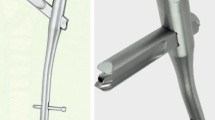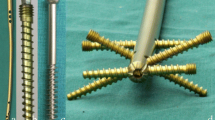Abstract
Introduction:
Due to the increase in the incidence of osteoporosis with age and the high biochemical load on the proximal femur, the pertrochanteric femur fracture is the typical fracture of the elderly. The number of different fracture types and the characteristic features of this patient population places high demands on any universally applicable implant. The rotational instability of the head–neck fragment in the case of a trochanter minor defect, in particular, is a significant factor in the care of pertrochanteric femur factures. The object of this study was to show that the gliding nail constitutes a universal implant for the care of proximal femur fractures with constantly maintained stability under load.
Material and Methods:
Between March 1996 and April 2001, 501 patients with per- and subtrochanteric fractures and an average age of 76 were included in the study. All osteosyntheses were carried out using the gliding nail which has an I-beam cross-section profile blade. 73.2% were treated operatively for closed isolated per- or subtrochanteric femur fractures.
Results:
All patients were restored to full weight-bearing postoperatively. The combined overall early and late complication rate following gliding nail synthesis was only 5.4%. Neither blade cut-out nor head–neck rotation was observed following gliding nail osteosynthesis. Three-month mortality rose from 2.4% in patients with no complications to 90% in patients with four complications. 92.1% of patients were independently mobile at the time of the follow-up examination.
Conclusion:
With its low complication rate and the ever-present possibility of full weight bearing, the gliding nail fulfills all the requirements of a modern implant for the treatment of proximal femur fractures. In our opinion, its most advantageous features are the high moment of resistance of the I-beam cross-section profile blade which ensures the possibility of gliding, the minimalized risk of proximal cut-out due to the large surface area with two planes of support in the bone, and its secure rotational stability in terms of both nail and bone. The impaction of the blade, which requires no reaming with its resulting loss of bone substance, is responsible for the excellent bone–implant interface.
Similar content being viewed by others
Author information
Authors and Affiliations
Corresponding author
Rights and permissions
About this article
Cite this article
Gehr, J., Arnold, T., Hilsenbeck, F. et al. The Gliding Nail, a Universal Implant in the Treatment of Proximal Femur Fractures. Eur J Trauma 32, 562–569 (2006). https://doi.org/10.1007/s00068-006-5117-2
Received:
Accepted:
Published:
Issue Date:
DOI: https://doi.org/10.1007/s00068-006-5117-2




